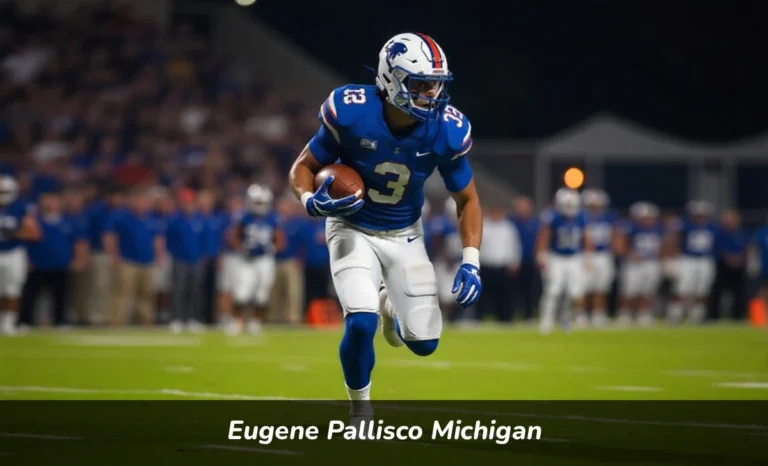Eugene Pallisco emerged as a multi-position athlete at Milford High School in Highland, Michigan, playing running back and middle linebacker for the class of 2020. His recruiting journey took him through multiple college offers before ultimately committing to Southern Utah in 2025, showcasing the long path many high school athletes take to reach the collegiate level.
Milford High School Career Highlights
Eugene Pallisco played for the Milford Mavericks in Highland, Michigan, where he demonstrated versatility by playing both offensive and defensive positions. Standing out as a running back and middle linebacker, Pallisco drew attention from college scouts during his high school tenure.
His athletic profile showed competitive measurables for his position:
- 40-yard dash: 4.59 seconds
- Shuttle run: 3.98 seconds
- Broad jump: 10.5 feet
These combined results placed him in the conversation for small college programs looking for two-way players who could contribute immediately.
College Recruitment Process
Pallisco’s recruitment journey reflects the reality many high school athletes face. The process began in 2019 when Hope College offered him a roster spot. Hope, a Division III program in Holland, Michigan, showed early interest in his dual-threat capabilities.
The recruitment landscape shifted dramatically for Pallisco after his 2020 graduation. What followed was an extended period of college exploration spanning several years:
Early Offers (2020-2021)
- Hope College (roster spot)
- Utah State (preferred walk-on offer, January 2021)
- Nebraska (offer, January 2021)
- Hocking College
Later Opportunities (2022-2023)
- Holmes Community College (multiple offers, 2022-2023)
- Minnesota State Community and Technical College (2022-2023)
- Anderson University (2023)
Final Destination (2025)
- Southern Utah commitment (March 2025)
This timeline reveals a common pattern in football recruiting. Many athletes don’t follow the traditional path from high school to college. Pallisco’s journey took five years from graduation to his eventual commitment, demonstrating the persistence required in pursuing athletic opportunities.
What Sets His Story Apart
Pallisco’s recruitment differs from typical high school football narratives in several ways. First, he received interest from programs across three different levels: Division I FBS (Utah State, Nebraska), junior colleges (Hocking, Holmes, Minnesota State), and Division III (Hope). This spread suggests coaches saw potential but disagreed on which competitive level suited him best.
Second, the gap between his 2020 high school graduation and his 2025 college commitment indicates he likely pursued other paths during those intervening years. Many athletes in similar situations work jobs, attend prep schools, or play at lower levels before earning opportunities at their desired institutions.
Third, his position versatility (running back, middle linebacker, tight end) made him attractive to programs needing adaptable players. Smaller programs often prize athletes who can contribute on both sides of the ball.
Michigan High School Football Context
Milford High School competes in Oakland County, one of Michigan’s most competitive high school football regions. The school produces college prospects regularly, though most land at Division II, Division III, or junior college programs rather than major Division I schools.
The Mavericks football program emphasizes fundamentals and player development. Athletes from Milford who reach the college level typically succeed through work ethic and coachability rather than pure athletic dominance.
Michigan’s high school football landscape produces approximately 200-300 college signees annually across all levels. The state’s recruiting scene revolves heavily around Detroit-area powerhouses, making it challenging for suburban programs like Milford to gain widespread attention.
Key Takeaways for Aspiring Athletes
Pallisco’s journey offers several lessons for high school football players:
Your timeline doesn’t have to match others. The five-year gap between graduation and commitment isn’t failure. Many athletes need time to develop physically, academically, or financially before college becomes viable.
Position flexibility matters. Coaches value players who can fill multiple roles, especially at smaller programs with limited roster sizes.
Persistence pays off. Pallisco continued pursuing opportunities years after his high school career ended, ultimately landing at a Division I program.
Final Thoughts
Eugene Pallisco’s path from Milford High School to Southern Utah represents the reality of college football recruiting for most athletes. While headlines focus on five-star recruits signing with powerhouse programs, thousands of players like Pallisco work through years of uncertainty before finding their place.
His story reminds us that athletic careers rarely follow straight lines. The commitment to Southern Utah in 2025 caps a recruiting journey that started in 2019, demonstrating that opportunities can emerge when athletes remain ready and willing to chase them.
For Michigan high school football players watching their recruiting unfold, Pallisco’s experience offers both caution and hope. The process can take longer than expected, but doors can still open years after high school ends.
FAQs
Where did Eugene Pallisco play high school football?
Eugene Pallisco played at Milford High School in Highland, Michigan, as part of the class of 2020.
What positions did Eugene Pallisco play?
Pallisco played multiple positions, including running back, middle linebacker, and tight end, during his high school and recruiting career.
Which college did Eugene Pallisco commit to?
Pallisco committed to Southern Utah in March 2025, five years after graduating high school.
Did Eugene Pallisco receive Division I offers?
Yes, Pallisco received a preferred walk-on offer from Utah State and an offer from Nebraska in January 2021.
How long did Eugene Pallisco’s recruiting process take?
His recruitment spanned approximately six years, from initial offers in 2019 to his final commitment in 2025.

